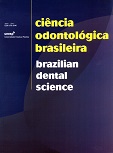Diagnóstico de cárie oclusal em dentes permanentes: estudo in vitro
DOI:
https://doi.org/10.14295/bds.2003.v6i3.610Abstract
O objetivo do presente trabalho foi comparar métodos de diagnóstico clínico de cárie oclusal in vitro, considerando-se a concordância entre eles. Faces oclusais de 32 dentes humanos extraídos foram analisadas, utilizando-se método visual, radiografia interproximal convencional, transiluminação por fibra óptica (FOTI), laser diodo (DIAGNOdent‚) e radiografia digital direta (RDD). Os resultados obtidos entre diferentes métodos foram comparados com o exame histológico ("padrão ouro"). O método mais sensível foi a inspeção visual (0,67), seguindo-se associação da inspeção visual com radiografia interproximal (0,58). Os métodos mais específicos foram a associação da inspeção visual com a radiografia interproximal (0,90) e a transiluminação por fibra óptica (0,90). O método com menor especificidade foi a radiografia digital direta (0,30).Downloads
Downloads
Published
How to Cite
Issue
Section
License
Brazilian Dental Science uses the Creative Commons (CC-BY 4.0) license, thus preserving the integrity of articles in an open access environment. The journal allows the author to retain publishing rights without restrictions.
=================




























